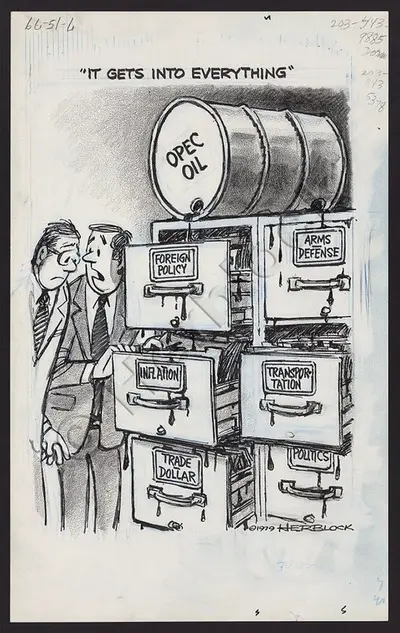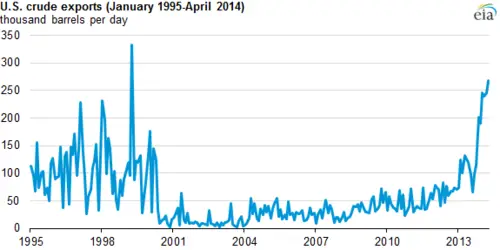Keep All "American Oil and Gas" Here in America
It Gets Into Everything,” 1979. Graphite, crayon, porous point pen, ink, and opaque white over blue pencil and graphite underdrawing. Published in the Washington Post, July 15, 1979. Prints and Photographs Division, Library of Congress (55.00.00). LC-DIG-ppmsca-21950
• SEE ALSO: Why Every Vehicle In America Should Use Non-Exportable Fuel
By Bob Gordon
President and Co-publisher
The Auto Channel
AUTO CENTRAL - June 30, 2014: With the Arab OPEC nations exploding, or in danger of exploding, The Auto Channel is calling for a temporary suspension of export licenses for all petroleum and natural gas products.
In spite of the record domestic production of oil and natural gas in the U.S. these past two years, the price of fuel has continued to rise for American motorists and the industries that rely on natural gas for power.
Just imagine what will happen to the price of gasoline here in the USA when the world price for oil and gas truly reflects the Chinese demand and a growing uncertainty for continuing production in the Middle Eastern OPEC nations and the upward pressure on prices of the available oil.
The “drill baby drill” scenario can get our support only when there is a guarantee that every drop of American Oil stays here in America.
As we all know there are no American Oil Companies when our domestically produced oil is sold across the seas to the highest bidder, making the “owners” of the land under which lies our abundant resource just another potential bidder for the monopoly that is oil. Even some of the oil industry's top paid supporters agree that all oil is controlled by foreign regimes (many that are enemies of the United States).
How can protecting the economy of our nation not be the prime focus of our bought and paid for Washington based oil sycophants.
Enough is Enough!
U.S. crude exports in April rise to highest level in 15 years

The United States exported 268,000 barrels per day (b/d) of crude oil in April (the latest data available from the U.S. Census Bureau), the highest level of exports in 15 years. Exports have increased sharply since the start of 2013 and have exceeded 200,000 b/d in five of the past six months. The increase in crude exports is largely the result of rising U.S. crude production, which was 8.2 million b/d in March.
To export crude oil from the United States, a company must obtain a license from the Bureau of Industry and Security (BIS) of the U.S. Department of Commerce. Under export licensing requirements, the following kinds of transactions will generally be approved:
- Exports from Alaska's Cook Inlet
- Exports to Canada for consumption or use therein
- Exports in connection with the refining or exchange of strategic petroleum reserve oil
- Exports that are consistent with international energy supply agreements
- Exports of foreign-origin crude
- Exports of California heavy crude up to an average of 25,000 b/d
- Temporary exports or exchanges
Licenses for other exports of U.S.-origin crude are considered on a case-by-case basis. For such other exports, the regulations describe the characteristics of transactions that will generally be approved as in the national interest.

Note: 2014 regional data are through March. PADD denotes Petroleum Administration for Defense District.
Almost all of the crude oil exported from the United States has been delivered to Canada, and most of the recent increase in crude oil exports has been from the U.S. Gulf Coast (PADD 3). Gulf Coast crude exports averaged 134,000 b/d in the first quarter of 2014, a 283% increase over 2013's record high of 35,000 b/d. In the first quarter of 2014, nearly 75% of Gulf Coast exports have left the region from the Houston-Galveston district, in Texas. The remaining barrels were loaded in Port Arthur, Texas and New Orleans, Louisiana.
Exports from the East Coast (PADD 1) averaged 30,000 b/d in the first quarter of 2014, down slightly from 2013 levels, but up from 9,000 b/d in 2012. First-quarter exports from PADD 1 were evenly distributed between the Port of New York and Portland, Maine, which is the starting point of a pipeline that delivers crude to refineries in the Montreal area. Exports of crude from the Midwest (PADD 2) have long been a source of crude for refineries in Sarnia, Ontario.
Principal contributor: Hannah Breul




